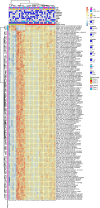DNA methylation profiling reveals common signatures of tumorigenesis and defines epigenetic prognostic subtypes of canine Diffuse Large B-cell Lymphoma
- PMID: 28912427
- PMCID: PMC5599585
- DOI: 10.1038/s41598-017-11724-w
DNA methylation profiling reveals common signatures of tumorigenesis and defines epigenetic prognostic subtypes of canine Diffuse Large B-cell Lymphoma
Abstract
Epigenetic deregulation is a hallmark of cancer characterized by frequent acquisition of new DNA methylation in CpG islands. To gain insight into the methylation changes of canine DLBCL, we investigated the DNA methylome in primary DLBCLs in comparison with control lymph nodes by genome-wide CpG microarray. We identified 1,194 target loci showing different methylation levels in tumors compared with controls. The hypermethylated CpG loci included promoter, 5'-UTRs, upstream and exonic regions. Interestingly, targets of polycomb repressive complex in stem cells were mostly affected suggesting that DLBCL shares a stem cell-like epigenetic pattern. Functional analysis highlighted biological processes strongly related to embryonic development, tissue morphogenesis and cellular differentiation, including HOX, BMP and WNT. In addition, the analysis of epigenetic patterns and genome-wide methylation variability identified cDLBCL subgroups. Some of these epigenetic subtypes showed a concordance with the clinical outcome supporting the hypothesis that the accumulation of aberrant epigenetic changes results in a more aggressive behavior of the tumor. Collectively, our results suggest an important role of DNA methylation in DLBCL where aberrancies in transcription factors were frequently observed, suggesting an involvement during tumorigenesis. These findings warrant further investigation to improve cDLBCL prognostic classification and provide new insights on tumor aggressiveness.
Conflict of interest statement
The authors declare that they have no competing interests.
Figures




Similar articles
-
Epigenetic silencing of TFPI-2 in canine diffuse large B-cell lymphoma.PLoS One. 2014 Apr 2;9(4):e92707. doi: 10.1371/journal.pone.0092707. eCollection 2014. PLoS One. 2014. PMID: 24695110 Free PMC article.
-
Identification and functional relevance of de novo DNA methylation in cancerous B-cell populations.J Cell Biochem. 2010 Mar 1;109(4):818-27. doi: 10.1002/jcb.22461. J Cell Biochem. 2010. PMID: 20069569 Free PMC article.
-
Methylation contributes to imbalance of PRDM1α/PRDM1bβ expression in diffuse large B-cell lymphoma.Leuk Lymphoma. 2015;56(8):2429-38. doi: 10.3109/10428194.2014.994181. Epub 2015 Jan 21. Leuk Lymphoma. 2015. PMID: 25487076
-
Comparison of genome-wide analysis techniques to DNA methylation analysis in human cancer.J Cell Physiol. 2018 May;233(5):3968-3981. doi: 10.1002/jcp.26176. Epub 2017 Oct 4. J Cell Physiol. 2018. PMID: 28888056 Review.
-
Gene methylation in gastric cancer.Clin Chim Acta. 2013 Sep 23;424:53-65. doi: 10.1016/j.cca.2013.05.002. Epub 2013 May 10. Clin Chim Acta. 2013. PMID: 23669186 Review.
Cited by
-
Genomics and transcriptomics in veterinary oncology.Oncol Lett. 2021 Apr;21(4):336. doi: 10.3892/ol.2021.12597. Epub 2021 Feb 26. Oncol Lett. 2021. PMID: 33692868 Free PMC article. Review.
-
DNA methylation-based lung adenocarcinoma subtypes can predict prognosis, recurrence, and immunotherapeutic implications.Aging (Albany NY). 2020 Nov 21;12(24):25275-25293. doi: 10.18632/aging.104129. Epub 2020 Nov 21. Aging (Albany NY). 2020. PMID: 33234739 Free PMC article.
-
Use of genome-wide DNA methylation analysis to identify prognostic CpG site markers associated with longer survival time in dogs with multicentric high-grade B-cell lymphoma.J Vet Intern Med. 2024 Jan-Feb;38(1):316-325. doi: 10.1111/jvim.16931. Epub 2023 Dec 19. J Vet Intern Med. 2024. PMID: 38115210 Free PMC article.
-
Mutational landscape of canine B-cell lymphoma profiled at single nucleotide resolution by RNA-seq.PLoS One. 2019 Apr 24;14(4):e0215154. doi: 10.1371/journal.pone.0215154. eCollection 2019. PLoS One. 2019. PMID: 31017932 Free PMC article.
-
Genome-wide DNA methylation analysis in canine gastrointestinal lymphoma.J Vet Med Sci. 2020 May 20;82(5):632-638. doi: 10.1292/jvms.19-0547. Epub 2020 Mar 25. J Vet Med Sci. 2020. PMID: 32213750 Free PMC article.
References
MeSH terms
LinkOut - more resources
Full Text Sources
Other Literature Sources
Molecular Biology Databases

